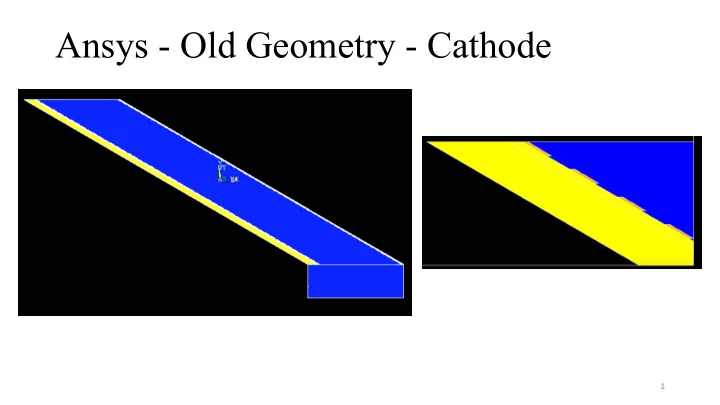

Ansys - Old Geometry - Cathode 1
Ansys - New Geometry - Cathode • lamella (PCB and copper strips) geometry is closer to realitiy • additional gas volumes 2
Ansys - New Geometry - GEM unit cell • Kapton layer with gas holes • complete unit cell • expansion in x-direction → later: in Garfield++ periodicity in z-direction 3
Ansys - Full geometry • pink: gas • Cathode area with lamella (cyan) • Drift area • Partial GEM foil (about +/- 2 mm from bottom of active volume) and gas volume at left and right • Induction area corrected gap size compared to geometry showed before 4
Ansys – Partial GEM Foil - Detail 5
Ansys Geometry - Meshing - Node Minimization • Node minimization for different volumes via ESIZE • no mid-node and angle warnings • less than 1% shape warnings • about 441.500 of 512.00 nodes used • Challenge: geometry with complete GEM Foil or 3 lamella with partial GEM exceeds free license node limitation 6
17.4 Potential distribution - new geometry with GEM • diffx = 90V • diffy = 400V • diff(cathode-GEMO) = 100V • Diff(GEMO-GEMU) = 300V • Add voltage at bottom of induction area!!! 7
16.4 Potential distribution GEM • +/- 2 mm from bottom of active volume • 300 V between GEM top and bottom • without cathode 8
20.4 Potential distribution without GEM old geometry new geometry without GEM • diffx = 400V, diffy = 90V, diff(anode) = 100V • voltage applied on same copper stripes (in new geometry on inner stripes) → slope of lines with same potential differs in active volume of both geometries 9
20.4 Resulting contours of electric field (y-component) new geometry without GEM old geometry • diffx = 400V, diffy = 90V, diff(anode) = 100V • voltage applied on same copper stripes (in new geometry on inner stripes) → contours of the electric field show differences 10
21.4 Efficiency of electron detection old geometry new geometry without GEM • diffy = 400V, diff(anode) = 100V, diffx = changed → about same maximum detection efficiency reached → but maximum moved from about diffx_max=88V (old) to diffx_max=115V (new) → gas volumes have influence on potential distribution and also on electron distribution 11
install new Ansys Simulation and get it to work get GEM geometry to work (convergence problem) TO DOs add voltage at bottom of induction area material properties take closer look at Garfield++ simulation (distribution of detected electrons, influence of GEM, correlation of y- position of created electrons and detected charge?, ...) 12
12.5 Ansys 2020 R1 – finally working • adapt my geometry script • adapt script for running complete simulation including ansys2020 and Garfield++ • 1 st : compare simulation results from ansys15 and ansys2020 to check if it’s working correctly 13
12.5 Potential distribution: Ansys 15 vs. Ansys 2020 R1 • diffx = 400V, diffy = 90V, diff(anode) = 100V • voltage applied on same copper stripes (in new geometry on inner stripes) → same potential distribution 14
13.5 Efficiency of electron detection: Ansys 15 vs. Ansys 2020 R1 • diffy = 400V, diff(anode) = 100V, diffx = changed → same detection efficiency for same voltage combinations → no differences: adapted scripts seem to work correctly 15
13.5 Continuing: Efficiency of electron detection old geometry new geometry without GEM (ansys2020) • diffy = 400V, diff(anode) = 100V, diffx = changed → about same maximum detection efficiency reached → but maximum moved from about diffx_max=88V (old) to diffx_max=117V (new) → gas volumes have influence on potential distribution and also on electron distribution 16
12.5 Task: Add complete GEM Foil partial GEM complete GEM • Potential distribution for diffx = 90V, diffy = 400V, diff(cathode-GEMO) = 100V, Diff(GEMO-GEMU) = 300V • complete GEM: areas with 0V 18
12.5/13.5 Closer look at GEM Foil • add partial GEM: (13+x+3) mm 19 • ∆U(top_GEMO)=100V; ∆U(GEMO_GEMU)=300V; ∆U(GEMU_bottom)=100V
12.5/13.5 Closer look at GEM Foil • add partial GEM: (13+x+3) mm 20
12.5/13.5 Closer look at GEM Foil • add partial GEM: (13+x+4) mm • ∆U(top_GEMO)=100V; ∆U(GEMO_GEMU)=300V; ∆U(GEMU_bottom)=100V → same voltage → 1 mm more at the right compared to previous geometry → but different potential distribuation 21
12.5/13.5 Closer look at GEM Foil • add partial GEM: (13+x+4) mm → volume with 0V 22 → Electric field vectors “stay” in their volume
Field in GEM 08.5 23
14.5 Update: Closer look at GEM Foil • whole GEM volume is now embedded in one gas volume including drift and induction area • ∆U(top_GEMO)=100V; ∆U(GEMO_GEMU)=300V; ∆U(GEMU_bottom)=100V • left: 5 GEM unit cells 24 • right: extend to 121 GEM unit cells
14.5 Electric field vector 25
Add cathode 20.5 • with about 5mm (121 unit cells) gas volume at right → VGLUE error ↯ → use 4mm at right • also without cathode the number of GEM unit cells is limited → with 141 unit cell: VGLUE error (maybe VSBV doesn’t work) ↯ • Potential distribution for diffx = 90V, diffy = 400V, ∆U(cathode_GEMO)=100V, ∆U(GEMO_GEMU)=300V, ∆U(GEMU_bottom)=100V and electric field vectors 26
19.5 Add GEM step by step only GEM metal top GEM metal top and Kapton layer 27
20.5 Add GEM step by step complete GEM: potential distribution Contours of the electric field in (y-component) diffx = 90V, diffy = 400V, ∆U(cathode_GEMO)=100V, ∆U(GEMO_GEMU)=300V, ∆U(GEMU_bottom)=100V → no electrons can be detected ↯ 28
20.5 Add GEM step by step corresponding vector plot Contours of the electric field in (y-component) diffx = 90V, diffy = 400V, ∆U(cathode_GEMO)=100V, ∆U(GEMO_GEMU)=300V, ∆U(GEMU_bottom)=100V 29 → seems like electric field in GEM is not homogenous ? ↯
Recommend
More recommend